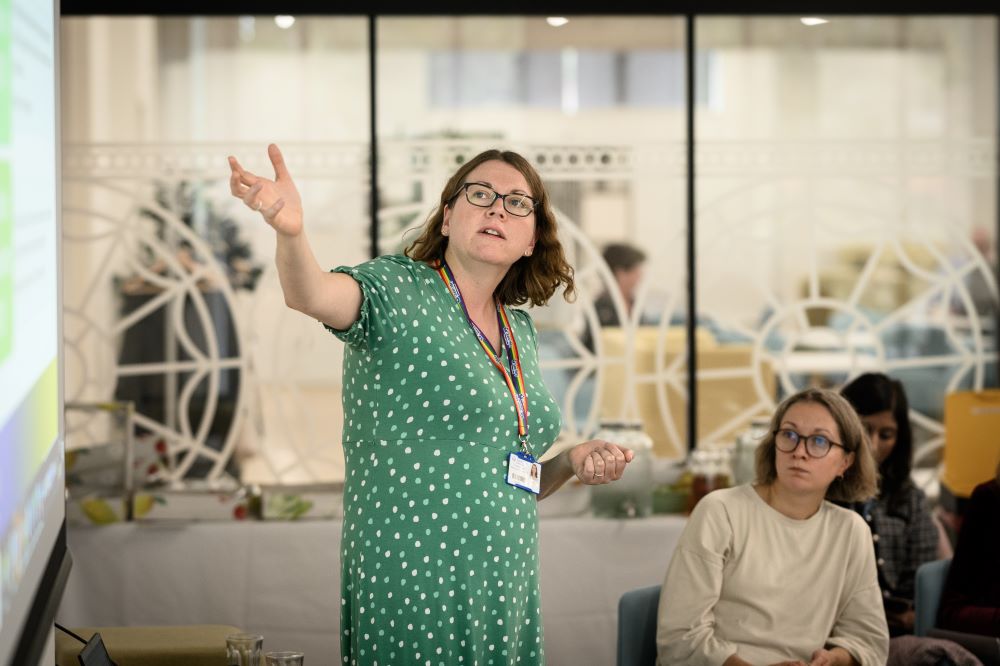This is an interview with Steph Fuller from Queen Mary Academy.


Tell me a little bit about yourself?
I work in the Queen Mary Academy which delivers university-wide support for the development of education and research. We work with staff and students to develop and enhance their practice in teaching, learning, scholarship, research, and academic leadership. I am in the Education and Recognition team that runs training courses and provides continuing professional development opportunities for educators, as well as support for staff seeking recognition for their teaching through Advance HE Fellowships. I lead the taught programmes in education development, CILT (Certificate in Learning and Teaching) and PGCAP (Postgraduate Certificate in Academic Practice ) and am also involved in curriculum enhancement work. I am particularly interested in areas including inclusivity, active learning, curriculum development, and graduate attributes.
“Curriculum enhancement”, what precisely does that mean?
This is working together with academics to develop course design. So exploring, at a design level, if we can enhance courses to better meet student needs, improve their learning and better align them with Queen Mary Strategy. For example, we might look at changing assessment design, revising learning outcomes, enhancing inclusivity in course materials or embedding employability.
What does inclusivity in teaching mean to you?
It means creating an environment that enables all students to participate and to achieve their best regardless of their background or any differences. Often people think about diversifying content, for example what authors are represented in a reading list or diversity in the range of speakers we invite to talk to students. Teaching practices can also be more or less inclusive, and we want staff to consider how they can be inclusive in the way that they teach too and how they can create an inclusive learning environment.
You have a particular interest in active learning, how does that relate to inclusivity?
I am interested in active learning – active techniques are a very broad spectrum. At one end you might take a traditional lecture but break it up with quizzes and questions that are easy to integrate. This goes all the way to a flipped classroom where the “lecture” is a recording and the students apply the knowledge in groups or individually with the teaching staff coordinating this during contact time. Traditional lectures require students to engage individually in a very specific way to learn, and not all students find this easy, depending on their educational background, preferences or learning differences. Active learning can be a way to encourage and enable all students to engage deeply with content and actively apply their knowledge, enhancing their learning. Research shows that active learning is effective in enhancing student learning, and that it can reduce attainment gaps between groups.
In EECS we are often teaching large classes what techniques might work here?
If the students are used to traditional lectures then shifting immediately to flipped classroom for example can be a big step. Moving more gradually with small steps might be helpful, such as integrating Mentimeter quizzes into a lecture. Build in an active
element like this from the start and then you can add to it. You can include short exercises where students are paired or working in groups. A “minute paper” can also be useful, where students write for a minute what are the main concepts they learned, or what they found to be the “muddiest point,” (most unclear elements) of a lecture. This can then be collected by the lecturer perhaps on post it notes or online via Mentimeter / Padlet and used to guide future teaching or provide additional support materials if needed.
In large classes active participation can be stressful, particularly if students are not native English speakers. How can you make this easier?
Giving students warning that participation will be expected is important, so questions are not a surprise. Provide questions in advance of a session so students can prepare their response. Giving students time to work in small groups and present to each other and then having one student presenting for the group can work well. The inclusiveness of the whole setting is also important and setting ‘ground rules’ at the start of a module or semester can be useful. We can think about developing a “learning contract” together with students, setting out how they will engage with staff and with each other (e.g. respecting each other, listening to others, contributing to activities / discussions). This could be formally written down or demonstrated informally by encouraging behaviour that meets the learning contract.
What would you say is the key to inclusive learning?
There is no “one-size fits all”. You need to think about and understand who your students are. You need to be proactive about inclusive design and flexible in trying out approaches. Talk to your students – ask them how they want to engage and what would make them feel included. Taking a look at the Queen Mary Principles of Inclusive Curriculum is a great place to start!